The Global Jojoba Oil Infusions Market is expected to record a valuation of USD 871.1 million in 2025 and USD 2,762.4 million in 2035, with an increase of USD 1,891.3 million, which equals a growth of more than 193% over the decade. The overall expansion represents a CAGR of 12.2% and reflects a more than 2X increase in market size.
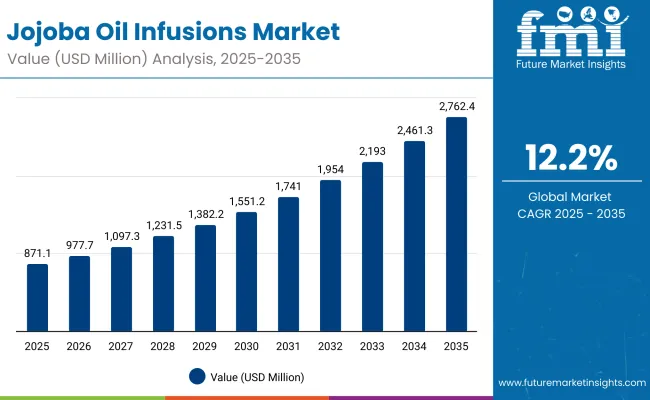
| Metric | Value |
|---|---|
| Global Jojoba Oil Infusions Market Estimated Value in (2025E) | USD 871.1 million |
| Global Jojoba Oil Infusions Market Forecast Value in (2035F) | USD 2,762.4 million |
| Forecast CAGR (2025 to 2035) | 12.2% |
During the first five-year period from 2025 to 2030, the market increases from USD 871.1 million to USD 1,551.2 million, adding USD 680.1 million, which accounts for around 36% of the total decade growth. This phase records steady adoption in moisturizing serums, hydrating creams, and natural oil-based formulations, driven by the need for hydration and skin barrier support. Moisturizing leads this period as it caters to over 41% of skincare applications requiring long-lasting hydration and smooth texture.
The second half from 2030 to 2035 contributes USD 1,211.2 million, equal to around 64% of total growth, as the market jumps from USD 1,551.2 million to USD 2,762.4 million. This acceleration is powered by widespread adoption of organic and vegan-infused products, clean-label certifications, and sustainable sourcing in both premium and mass-market beauty lines. Oils and serums together capture a larger share above 50% by the end of the decade. E-commerce-led distribution and subscription beauty boxes add recurring revenue, increasing the digital channel share beyond 48% in total value.
From 2020 to 2024, the Global Jojoba Oil Infusions Market grew from USD 590 million to USD 830 million, driven by hydration- and anti-aging-centric adoption. During this period, the competitive landscape was dominated by natural beauty brands controlling nearly 70% of revenue, with leaders such as Desert Essence, The Jojoba Company, and Burt’s Bees focusing on clean, organic oil blends for skincare and haircare. Competitive differentiation relied on purity, ethical sourcing, and eco-friendly packaging, while conventional mass brands often positioned jojoba oils as secondary to other botanicals. Direct-to-consumer models and small indie beauty houses contributed less than 15% of the total market value.
Demand for jojoba oil infusions will expand to USD 871.1 million in 2025, and the revenue mix will shift as organic, vegan, and sustainable sourcing claims grow to over 55% share. Traditional leaders face rising competition from digital-first clean beauty players offering cruelty-free, vegan-certified oils and AI-driven personalization of serums and blends. Major oil infusion brands are pivoting to hybrid models, integrating e-commerce, refillable packaging, and influencer-led marketing to retain relevance. Emerging entrants specializing in sustainably sourced raw jojoba oils, Ayurvedic fusions, and science-backed anti-aging infusions are gaining share. The competitive advantage is moving away from product formulation alone to holistic brand ecosystems, transparency, and customer loyalty programs that create recurring revenue streams.
Advances in natural formulation science have improved the stability and absorption of jojoba oil in emulsions, serums, and multi-use blends, allowing for more effective skincare results across diverse applications. Moisturizing-led demand has surged due to its suitability for hydration, soothing sensitive skin, and improving barrier repair. The rise of organic and clean-label certifications has contributed to consumer trust, while sustainable sourcing resonates with eco-conscious buyers. Industries such as cosmeceuticals, natural haircare, and premium personal care are driving demand for jojoba oil solutions that integrate seamlessly with daily routines. Expansion of vegan beauty and cruelty-free skincare has fueled market growth. Innovations in portable refill packs, subscription e-commerce channels, and hybrid blends (combining jojoba with ceramides or actives) are expected to open new application areas. Segment growth is expected to be led by moisturizing and repairing functions, oils in product type categories, and e-commerce as a primary sales channel due to its reach and customization opportunities.
The market is segmented by function, product type, channel, claim, and geography. Functions include moisturizing, soothing & calming, anti-aging, and repair & nourishment, highlighting the multi-purpose role of jojoba oils. Product types span oils, serums, creams & lotions, and haircare blends. Channel distribution covers e-commerce, mass retail, pharmacies, and specialty beauty stores, catering to different consumer touchpoints. Claims include organic, vegan, clean-label, and sustainable sourcing. Regionally, the scope spans North America, Europe, East Asia, South Asia & Pacific, Latin America, and the Middle East & Africa.

| Function Segment | Market Value Share, 2025 |
|---|---|
| Moisturizing | 45.1% |
| Others | 54.9% |
The moisturizing segment is projected to contribute 45.1% of the Global Jojoba Oil Infusions Market revenue in 2025, maintaining its lead as the dominant functional category. This is driven by the rising preference for hydration-focused skincare routines, demand for serums and creams that improve water retention, and long-lasting comfort for dry and sensitive skin. The segment’s growth is also supported by the widespread adoption of multifunctional moisturizers, blending jojoba oils with botanical actives, peptides, or ceramides to appeal to consumers seeking comprehensive solutions. With heightened awareness of barrier repair and “skinimalism” trends, moisturizing jojoba oil infusions are expected to remain the backbone of the market through 2035.
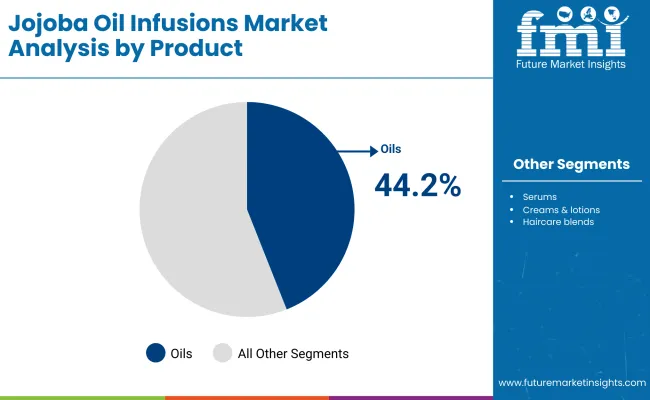
| Product Type Segment | Market Value Share, 2025 |
|---|---|
| Oils | 44.2% |
| Others | 55.8% |
The oils segment is forecasted to hold 44.2% of the market share in 2025, led by its role in both direct application and integration in DIY skincare and haircare routines. Oils are favored for their purity, versatility, and long shelf life, making them the base for infusions in premium formulations as well as mass-market products.
Their simple composition and broad consumer recognition have facilitated widespread adoption across USA, China, and India, where oils remain culturally rooted in self-care practices. Growth is bolstered by rising popularity of clean beauty oils marketed as single-ingredient heroes. Oils are expected to maintain dominance as the primary gateway segment into jojoba infusions.
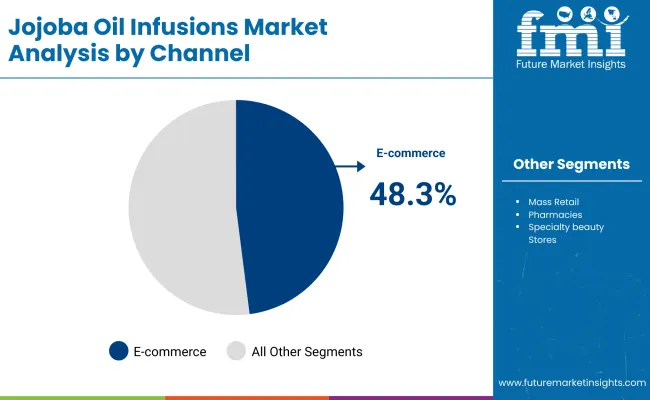
| Channel Segment | Market Value Share, 2025 |
|---|---|
| E-commerce | 48.3% |
| Others | 51.7% |
The e-commerce segment is projected to account for 48.3% of the Global Jojoba Oil Infusions Market revenue in 2025, establishing it as the fastest-growing channel. Online platforms offer direct-to-consumer sales, subscription models, and wider access to niche clean beauty brands that rely heavily on digital marketing and influencer collaborations.Its suitability for personalized product recommendations, loyalty programs, and eco-friendly refill systems has made it especially attractive. With accelerating digital adoption in Asia and ongoing retail disruption in North America and Europe, e-commerce is expected to solidify its position as the primary sales channel through 2035.
Rising Consumer Shift Toward Natural, Vegan, and Clean-label Products
The strongest driver for the Global Jojoba Oil Infusions Market is the accelerating consumer preference for natural and plant-based beauty ingredients. Jojoba oil aligns perfectly with the clean beauty movement because it is non-comedogenic, hypoallergenic, and mimics the skin’s natural sebum. This has increased its adoption across moisturizers, serums, and haircare blends. The growth of vegan-certified beauty products also positions jojoba as a key alternative to animal-derived oils such as lanolin. Globally, over 55% of beauty buyers now prioritize organic, vegan, or clean-label claims, and this is particularly visible in younger demographics such as millennials and Gen Z, who not only demand efficacy but also want transparent sourcing and eco-conscious packaging. This demand shift is projected to continue fueling jojoba oil infusion sales well into 2035.
Expanding E-commerce and Direct-to-Consumer (D2C) Channels
Another major driver is the expansion of e-commerce platforms and subscription-based beauty services, which are accelerating the accessibility of jojoba oil infusions. Online channels accounted for 48.3% of global sales in 2025, and the share is expected to rise further as consumers increasingly shop for skincare digitally. Brands such as Desert Essence, Cliganic, and The Jojoba Company have optimized digital marketing strategies, influencer partnerships, and subscription refills to enhance consumer reach. This transition to online-first models is particularly effective in emerging Asian markets like China and India, where e-commerce penetration is driving double-digit growth rates. With e-commerce enabling personalized product recommendations and eco-friendly refill packaging, the channel has become a core enabler of long-term revenue growth in this market.
Price Volatility of Jojoba Oil Due to Supply Constraints
One of the key restraints is the high dependency on jojoba crop yields, primarily grown in arid regions such as Arizona, Mexico, and Israel. Fluctuations in climate, drought conditions, and land limitations can directly impact the availability of raw jojoba seeds, thereby increasing production costs for infused products. Since jojoba oil is not cultivated as extensively as other plant oils like coconut or argan, its supply is vulnerable to regional disruptions. This often leads to higher prices for consumers, limiting adoption in mass-market and budget-conscious categories, especially in developing economies where cost competitiveness remains critical.
Intense Competition from Alternative Plant Oils and Synthetics
While jojoba oil has unique benefits, it faces competition from widely available and cheaper oils such as argan, almond, and coconut, which are often used in moisturizing and haircare formulations. These oils have well-established global supply chains, making them more cost-effective for formulators and consumers. Additionally, synthetic emollients and lab-engineered oils are gaining traction due to their scalability and consistent performance. The rising R&D focus on lab-based bioidentical alternatives could reduce the reliance on natural jojoba oils, restraining the growth of jojoba oil infusions in mainstream skincare lines over the long term.
Sustainable Sourcing and Eco-friendly Packaging as Brand Differentiators
A leading trend shaping this market is the integration of sustainability into every stage of product development, from raw material sourcing to packaging. Brands are increasingly highlighting sustainable harvesting of jojoba seeds, fair-trade farming practices, and recyclable or biodegradable packaging formats. For example, refill packs and glass dropper bottles have become popular in premium jojoba oil serums. Consumers, especially in Europe and North America, now expect transparency in sourcing and carbon footprint reporting, making sustainability not just a marketing claim but a critical factor in purchase decisions. This trend is expected to differentiate leaders from laggards in the global jojoba oil infusions market by 2035.
Hybrid and Functional Blends Driving Innovation
Another key trend is the rise of hybrid jojoba oil infusions combined with bioactive ingredients such as ceramides, retinol, peptides, and antioxidants. While jojoba oil has historically been used in pure oil form, consumers increasingly seek multifunctional products that address multiple needs such as hydration, anti-aging, and repair in a single application. Brands are responding by launching innovative formats such as infused serums, creams, and haircare blends, where jojoba acts as both a delivery medium and a functional enhancer. In Asia-Pacific, for instance, hybrid products marketed as “all-in-one” moisturizers and calming agents are seeing rapid uptake. This convergence of traditional natural oils with high-tech actives is expected to drive premiumization and brand loyalty in the coming decade.
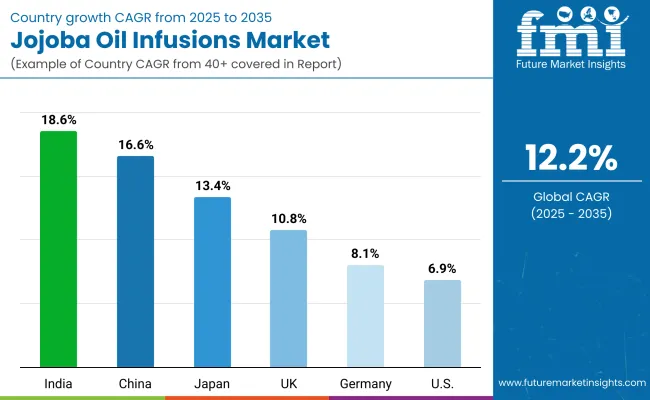
| Countries | Estimated CAGR (2025 to 2035) |
|---|---|
| China | 16.6% |
| USA | 6.9% |
| India | 18.6% |
| UK | 10.8% |
| Germany | 8.1% |
| Japan | 13.4% |
The country-level growth outlook for the Global Jojoba Oil Infusions Market (2025-2035) highlights significant regional variations driven by consumer behavior, industry maturity, and retail penetration. India (18.6% CAGR) and China (16.6% CAGR) lead the market, fueled by rising disposable incomes, a younger demographic adopting natural beauty products, and rapid expansion of e-commerce platforms. In these countries, the demand for moisturizing and nourishing oils is also tied to cultural familiarity with oil-based beauty rituals, which strengthens jojoba’s acceptance in both skincare and haircare. Japan (13.4% CAGR) shows strong momentum due to the integration of jojoba oils in high-tech cosmetic formulations, where hybrid serums and calming infusions resonate with the premium beauty segment. Collectively, these Asian markets represent the fastest growth zones, underscoring the region’s pivotal role in shaping the global trajectory.
In contrast, mature markets such as the USA (6.9% CAGR), UK (10.8% CAGR), and Germany (8.1% CAGR) display slower but steady expansion, reflecting established consumer awareness and the dominance of well-entrenched personal care brands. Growth in these markets is led by premium organic and vegan-certified jojoba infusions, with sustainability and transparency acting as strong purchase motivators. The USA remains the largest market by absolute value due to its scale, while Europe emphasizes regulatory-driven clean-label adoption, particularly in Germany and the UK. While these regions are not expanding as rapidly as Asia, they remain critical for premiumization and brand positioning, with innovations in sustainable sourcing and eco-friendly packaging setting global benchmarks.
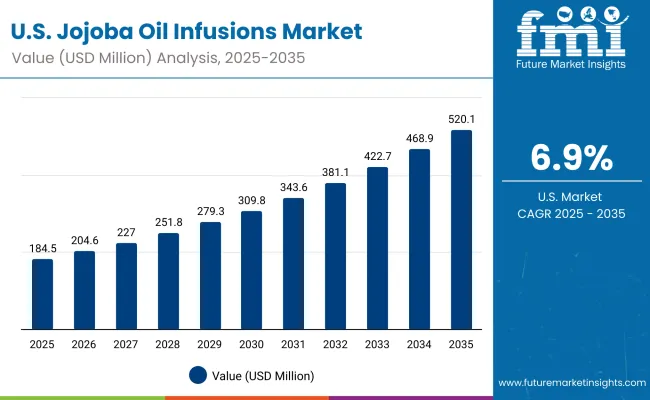
| Year | USA Jojoba Oil Infusions Market (USD Million) |
|---|---|
| 2025 | 184.5 |
| 2026 | 204.7 |
| 2027 | 227.0 |
| 2028 | 251.8 |
| 2029 | 279.3 |
| 2030 | 309.8 |
| 2031 | 343.6 |
| 2032 | 381.2 |
| 2033 | 422.8 |
| 2034 | 468.9 |
| 2035 | 520.1 |
The Jojoba Oil Infusions Market in the United States is projected to grow at a CAGR of 6.9%, led by strong adoption of hydration-focused skincare, premium organic oils, and sustainable beauty formulations. Moisturizing remains the dominant function, accounting for 41.4% of sales in 2025, with serums and creams targeted toward sensitive skin and anti-aging routines driving steady growth. E-commerce platforms and clean-label specialty retailers are further expanding consumer reach, with refill packs and subscription models gaining traction. Although competition from alternative plant oils remains, the USA market continues to be one of the largest in absolute value, reflecting its role as a mature yet innovation-driven hub.
The Jojoba Oil Infusions Market in the United Kingdom is expected to grow at a CAGR of 10.8%, supported by consumer demand for organic, vegan, and clean-label beauty solutions. Specialty retailers and pharmacies have accelerated listings of jojoba-based oils, lotions, and haircare blends, while mass retail is catching up through affordable private-label offerings. Heritage beauty and wellness brands are leveraging jojoba oil in soothing and anti-aging categories, targeting middle-aged and premium buyers. The strong cultural affinity for sustainability and eco-conscious packaging is further fueling growth.
India is witnessing rapid growth in the Jojoba Oil Infusions Market, which is forecast to expand at a CAGR of 18.6% through 2035, the highest among major markets. Rising consumer awareness of natural and ayurvedic-inspired beauty routines is creating strong adoption of jojoba oil in both skincare and haircare. Oils and blends dominate demand, while online-first brands and D2C models are penetrating tier-2 and tier-3 cities with affordable formats. Educational awareness campaigns and influencer-driven marketing are boosting trust in jojoba oil’s role as a natural moisturizer and repair agent.
The Jojoba Oil Infusions Market in China is expected to grow at a CAGR of 16.6%, driven by the premiumization of natural beauty, the rise of clean-label skincare, and fast-expanding digital retail ecosystems. Oils are the leading product type in 2025, accounting for 49.2% of sales, reflecting strong consumer acceptance of oil-based regimens. Local beauty startups and cross-border e-commerce platforms are introducing hybrid jojoba infusions with ceramides, peptides, and brightening actives, appealing to high-tech skincare buyers. Digital-first marketing campaigns, KOL-led endorsements, and integration into subscription boxes are driving mainstream awareness.
| Countries | 2025 Share (%) |
|---|---|
| USA | 21.2% |
| China | 10.8% |
| Japan | 6.3% |
| Germany | 13.9% |
| UK | 7.3% |
| India | 4.4% |
| Countries | 2035 Share (%) |
|---|---|
| USA | 18.8% |
| China | 11.7% |
| Japan | 7.6% |
| Germany | 12.1% |
| UK | 6.6% |
| India | 5.4% |
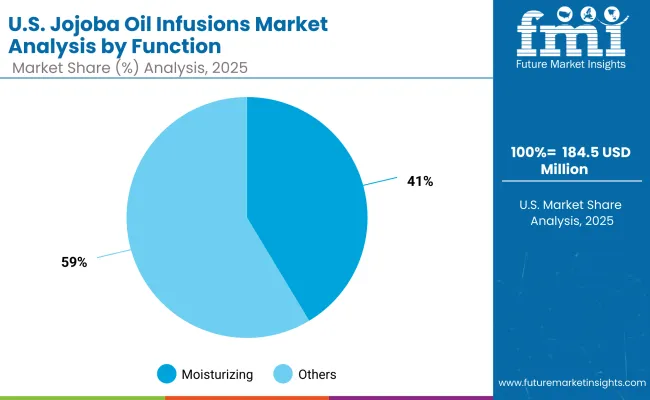
| Function Segment | Market Value Share, 2025 |
|---|---|
| Moisturizing | 41.4% |
| Others | 58.6% |
The Jojoba Oil Infusions Market in the United States is valued at USD 184.53 million in 2025, with moisturizing products leading at 41.4%, followed by other categories such as soothing, anti-aging, and repair & nourishment. The dominance of moisturizing solutions reflects the maturity of the USA skincare industry, where hydration and skin barrier restoration remain critical consumer demands. Dermatologist-endorsed brands and organic certifications enhance trust, while sustainability and cruelty-free positioning add value across premium channels.
Moisturizing infusions play a pivotal role in the USA beauty ecosystem, serving as essential daily-use items in both premium and mass categories. Their broad appeal across age groups, skin types, and retail platforms makes them indispensable. Other functions, particularly anti-aging, are growing steadily, supported by scientific claims and hybrid formulations combining jojoba with retinol, peptides, and antioxidants. As consumer preference for simplified yet effective routines expands, moisturizing jojoba oil products are expected to maintain leadership while synergizing with clean-label and eco-conscious demands.
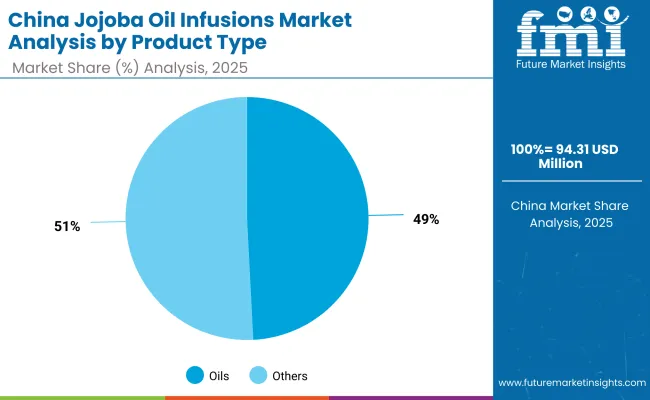
| Product Type Segment | Market Value Share, 2025 |
|---|---|
| Oils | 49.2% |
| Others | 50.8% |
The Jojoba Oil Infusions Market in China is valued at USD 94.31 million in 2025 (10.8% of global share), with oils leading at 49.2% of sales, reflecting the strong consumer preference for natural and pure formulations. Oils dominate as both direct-application skincare staples and versatile bases for hybrid beauty blends. This trend aligns with China’s long-standing cultural acceptance of oil-based treatments, coupled with rising consumer awareness of jojoba oil’s sebum-balancing and moisturizing properties.
E-commerce platforms and cross-border beauty marketplaces are fueling adoption by making international and premium jojoba oil brands accessible to urban consumers. Hybrid oils infused with active ingredients such as niacinamide and ceramides are increasingly marketed toward younger demographics, blending traditional natural beauty with modern cosmeceutical performance. With rapid growth in digital-first beauty retail, oils are expected to remain a central pillar of China’s jojoba oil infusion demand, while serums and multifunctional blends will expand in premium categories.
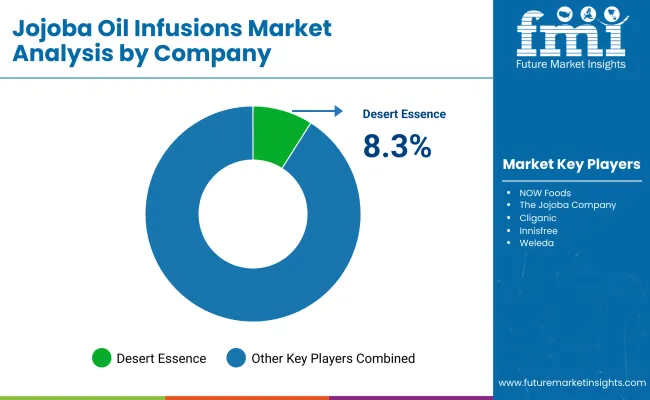
| Company | Global Value Share 2025 |
|---|---|
| Desert Essence | 8.3% |
| Others | 91.7% |
The Global Jojoba Oil Infusions Market is moderately fragmented, with a mix of established natural beauty brands, organic-focused specialists, and fast-growing digital-first entrants. Leading companies such as Desert Essence, The Jojoba Company, and Burt’s Bees hold significant market visibility, driven by their emphasis on organic certifications, transparent sourcing, and sustainable packaging. Their strategies increasingly highlight vegan positioning, eco-conscious branding, and integration into mainstream retail and e-commerce platforms.
Established mid-sized players including NOW Foods, Cliganic, and Weleda focus on affordability, purity, and accessibility, catering to growing demand in both North America and Europe. These brands capitalize on portable packaging formats and strong presence across pharmacies and online marketplaces, making them highly relevant for cost-sensitive but health-conscious consumers.
Premium specialists such as Osea Malibu, Innisfree, Paul Mitchell, and Leven Rose differentiate through targeted product lines, hybrid infusions, and high-end distribution. Their strength lies in creating strong consumer engagement through influencer marketing, direct-to-consumer subscription models, and advanced formulations blending jojoba oils with bioactives.Competitive differentiation is shifting from simple oil purity toward ecosystem-driven strategies, including sustainable sourcing certifications, recyclable and refillable packaging systems, and hybrid innovation combining natural oils with advanced actives. As the market accelerates toward 2035, ecosystem strength, digital brand reach, and premium positioning will increasingly outweigh single-product innovation in securing long-term leadership.
Key Developments in Global Jojoba Oil Infusions Market
| Item | Value |
|---|---|
| Quantitative Units | USD 871.1 million |
| Function | Moisturizing, Soothing & calming, Anti-aging, and Repair & nourishment |
| Product Type | Oils, Serums, Creams & lotions, and Haircare blends |
| Channel | E-commerce, Mass retail, Pharmacies, and Specialty beauty stores |
| Claim | Organic, Vegan, Clean-label, and Sustainable sourcing |
| Regions Covered | North America, Europe, Asia-Pacific, Latin America, Middle East & Africa |
| Country Covered | United States, Canada, Germany, France, United Kingdom, China, Japan, India, Brazil, South Africa |
| Key Companies Profiled | Desert Essence, NOW Foods, The Jojoba Company, Cliganic, Innisfree, Weleda, Burt’s Bees, Osea Malibu, Paul Mitchell, Leven Rose |
| Additional Attributes | Dollar sales by function, product type, and channel, adoption trends in moisturizing and oils, rising demand for vegan and organic claims, segment-specific growth in e-commerce and specialty retail, software-enabled D2C platforms, sustainable sourcing and eco-friendly packaging integration, regional trends influenced by natural beauty adoption, and innovations in hybrid jojoba oil infusions combining natural oils with peptides, ceramides, and botanicals. |
The Global Jojoba Oil Infusions Market is estimated to be valued at USD 871.1 million in 2025.
The market size for the Global Jojoba Oil Infusions Market is projected to reach USD 2,762.4 million by 2035.
The Global Jojoba Oil Infusions Market is expected to grow at a 12.2% CAGR between 2025 and 2035.
The key product types in the Global Jojoba Oil Infusions Market are oils, serums, creams & lotions, and haircare blends.
In terms of function, the moisturizing segment is projected to command 45.1% share of the Global Jojoba Oil Infusions Market in 2025.






Full Research Suite comprises of:
Market outlook & trends analysis
Interviews & case studies
Strategic recommendations
Vendor profiles & capabilities analysis
5-year forecasts
8 regions and 60+ country-level data splits
Market segment data splits
12 months of continuous data updates
DELIVERED AS:
PDF EXCEL ONLINE
Jojoba Oil Market Forecast Outlook 2025 to 2035
Oil-immersed Iron Core Series Reactor Market Size and Share Forecast Outlook 2025 to 2035
Oil and Gas Sensor Market Forecast Outlook 2025 to 2035
Oil Packing Machine Market Forecast and Outlook 2025 to 2035
Oil and Gas Pipeline Coating Market Forecast and Outlook 2025 to 2035
Oilfield Scale Inhibitor Market Size and Share Forecast Outlook 2025 to 2035
Oil-in-Water Anionic Emulsifier Market Size and Share Forecast Outlook 2025 to 2035
Oil and Gas Field Services Market Size and Share Forecast Outlook 2025 to 2035
Oil Control Shampoo Market Size and Share Forecast Outlook 2025 to 2035
Oil Expellers Market Size and Share Forecast Outlook 2025 to 2035
Oilfield Stimulation Chemicals Market Size and Share Forecast Outlook 2025 to 2035
Oiler Kits Market Size and Share Forecast Outlook 2025 to 2035
Oil Pressure Sensor Market Size and Share Forecast Outlook 2025 to 2035
Oil Filled Power Transformer Market Size and Share Forecast Outlook 2025 to 2035
Oily Skin Control Products Market Analysis - Size and Share Forecast Outlook 2025 to 2035
Oil Immersed Shunt Reactor Market Size and Share Forecast Outlook 2025 to 2035
Oil Country Tubular Goods Market Size and Share Forecast Outlook 2025 to 2035
Oil Filled Distribution Transformer Market Size and Share Forecast Outlook 2025 to 2035
Oilfield Communications Market Size and Share Forecast Outlook 2025 to 2035
Oil & Gas Electrification Market Size and Share Forecast Outlook 2025 to 2035

Thank you!
You will receive an email from our Business Development Manager. Please be sure to check your SPAM/JUNK folder too.
Chat With
MaRIA